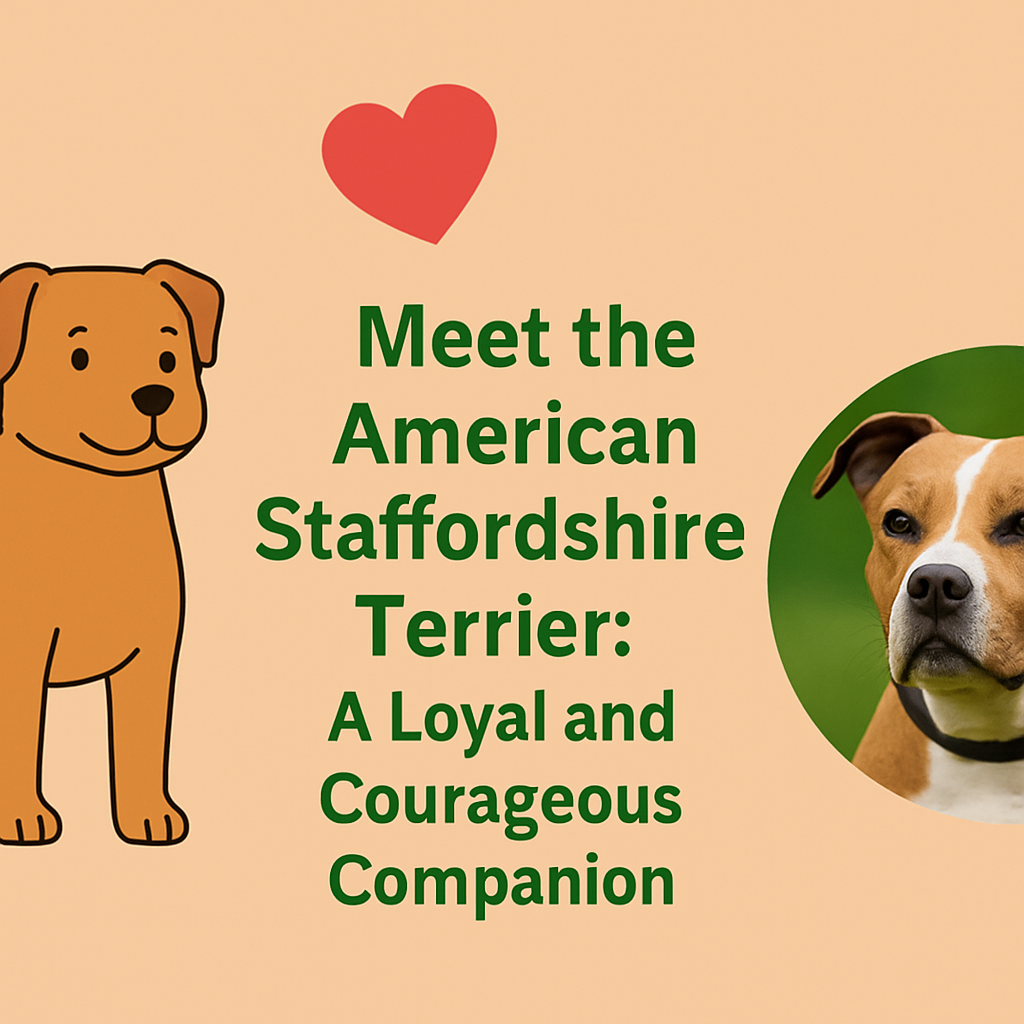Meet the American Staffordshire Terrier: A Loyal and Courageous Companion
The American Staffordshire Terrier, or AmStaff, is a strong but very affectionate dog. Maligned because of its build and previous history of engagement in bull-baiting, the AmStaff is in fact a friendly, loyal, and highly trainable dog. With proper treatment, they are one of the most affectionate family pets.
1. Origins and Breed History
The American Staffordshire Terrier has origins in the 19th century in England. They were developed by crossing bulldogs with terriers, initially bred for involvement in blood sports. Once they were brought to America, breeders moved away from cruelty and began working towards creating a more stable temperament.
The American Staffordshire Terrier was christened Staffordshire Terrier by the American Kennel Club in 1936. It was later nicknamed American Staffordshire Terrier in 1972, as opposed to its British counterpart, the Staffordshire Bull Terrier, in that it was smaller in stature and maintained as a family pet animal.
2. Physical Appearance
Muscular Yet Agile Build
AmStaffs possess a medium body build, muscular body structure, and extremely bold temperament. The males reach a height of around 18 to 19 inches and the females around 17 to 18 inches. Weight varies from 40 pounds to 70 pounds based on sex and muscle build.
Coat and Colors
Their short, smooth, and sleek coat requires very little maintenance. They come in many colors including black, brindle, blue, fawn, red, and solid white-marked or solid. Spotting and single markings are standard, and each AmStaff will be unique from the last.
Eyes, Ears, and Expression
They have round, dark eyes with a questioning, alert facial expression. Crop ears or natural (half-prick or rose-type), and are most often a confident mixture of friendliness and fierceness.
3. Temperament and Personality
Loyal and Brave
AmStaffs are extremely loyal. They are bred to develop a close bond with humans and possess a guarding instinct by birth and are thus great watchdogs. They are not naturally aggressive if well-socialized.
Playful and Affectionate
Dogs are not only tough-they’re extremely loving, too. They need human touch and human love to become part of the pack. Backyard playtime or cuddling on the couch, an AmStaff is happiest with you.
Good with Kids
Socialized AmStaffs tend to be gentle and obedient with children. Their rugged structure allows for play tolerance, and they become a family guardian.
4. Exercise and Activity Needs
High Energy, High Engagement
AmStaffs are high-energy dogs and need exercise physically and mentally on a daily basis. A morning walk, a little play fetch time, or a bit of agility training focuses the mind and the body.
Top Activities
- Tug-of-war
- Obedience training
- Hiking
- Dog sports (such as dock diving or flyball)
They like to work with their owners and test them to the limit.
Avoid Boredom
When left without supervision or stimulation, AmStaffs can become bored and destructive. Puzzles, toys, and routine prevent bad behavior.
5. Health and Wellness
Average Life Span
Healthy, well-bred American Staffordshire Terriers typically live between 12 and 16 years, with quality breeding and proper care playing a vital role in their longevity.
Diseases
As with all purebreds, AmStaffs are at risk of the following diseases:
- Hip and elbow dysplasia
- Skin allergies
- Hypothyroidism
- Progressive retinal atrophy
- Cerebellar ataxia (neurological disorder)
Proper vet visits, dieting, and prevention can detect such diseases in the early stages and have them treated.
Bathing and Nail Care
Bathe sparingly—excessive bathings lead to drying out. Clip regularly and inspect ears on a weekly basis for infection or irritation.
Dental Hygiene
Brush dog’s teeth a few times weekly to prevent tartar formation and gum disease.
8. Home and Family Suitability
Apartment or House
Though they’ll adapt to apartment life, AmStaffs would rather live in a house where they have space to roam and play. A fenced yard is ideal—but always keep an eye on them because they’re powerful and determined escape artists.
Time Alone
They don’t like to be home alone for long stretches of time. If you frequently work at home, dog daycare or a doggy playdate would be the answer.
Family Pets and Other Pets
They can be fostered together with other members of the family as pets but need to be socialised to other dogs under control. Socialisation should be done early here as well.
9. Breed Misconceptions
AmStaffs are often misinterpreted and wrongly labeled as aggressive dogs. But they are, if properly trained, one of the nicest and even-tempered of dogs to have. Training and actual ownership undo the common impression and keep this loyal dog in its proper place.
FAQ: American Staffordshire Terrier
Q1: Are American Staffordshire Terriers mean?
Not by nature. Well socialized and well trained, they are friendly, nice, and loving.
Q2: Are AmStaffs compatible with other dogs?
With early socialization and supervision, they can be nice in the presence of others. In any case, however, dog-to-dog interaction must be respectful and secure.
Q3: How much exercise will they require?
At least 60 minutes daily. Brain work is as essential as body work.
Q4: Do they shed heavily?
They shed less. Brush them every week, daily and loose hair will be maintained.
Q5: How well do they get along with family as pets?
Yes. AmStaffs are family-committed, child-tolerant, and family-committed highly.
Q6: Are AmStaffs apartment dwellers?
They prefer it in homes where they’re not home-sitting for long stretches of time.
Final Thoughts
The American Staffordshire Terrier is a combination of heart, loyalty, and courage. As large as the heart as the body itself, they are just as much deserving of the rewarding companionship of a person who will train, love, and lead them.
Look no further than the American Staffordshire Terrier for a pet dog to play with, to protect, and to love without hesitation.







